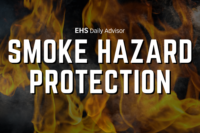Category: Emergency Preparedness and Response
No one wants it to happen, but an emergency, natural or manmade, can strike at anytime, 24/7. What’s more, it need not be a major, nationally-televised incident, such as a hurricane, earthquake, or act of political terror. An event as common as a local building fire can present just as large a challenge to you. These resources will help you create a plan for handling such crises, whatever their scope, and to carry it out in a way that best protects your employees and your company.
Free Special Report: 50 Tips for More Effective Safety Training
On episode 171 of EHS On Tap, Michael Kleeman, a member of the Scientific Advisory Council of the American Red Cross and head of the Disaster Cycle Sub-Council, discusses what businesses should know about hurricane preparedness.
On August 2, the U.S. Chemical Safety and Hazard Investigation Board (CSB) released a letter sent to the Federal Energy Regulatory Commission (FERC) urging the commission to address hurricanes and other high-wind extreme weather events in updates to its Transmission System Planning Performance Requirements for the nation’s bulk-power system. The CSB pointed out to FERC […]
Many parts of the country are experiencing significant rainfall that’s leading to widespread flooding and catastrophic damage in some areas. In addition, the Atlantic hurricane season, which runs from June 1 to November 30, is underway. Hurricanes are often accompanied by a storm surge that can also lead to significant flooding, so it’s important for […]
In a June 16 viewpoint article in JAMA, David Michaels, former assistant secretary of labor for occupational safety and health, wrote the Occupational Safety and Health Administration (OSHA) should take steps to better protect workers in future pandemics, including issuing a federal pandemic preparedness standard. Michaels, who served under President Barack Obama, was OSHA’s longest-serving […]
It is important that safety professionals understand particulate matter and wildfire smoke hazards, and how to keep workers safe when outdoor air quality decreases. Here’s what you need to know about protecting workers from smoke hazards.
Back to Basics is a weekly feature that highlights important but possibly overlooked information that any EHS professional should know. This week, we examine particulate matter pollution and the effects on human health and safety. Due to the recent wildfires and smoke on the East Coast and Canada, OSHA has urged employers to protect their […]
Public safety answering points (PSAPs) and emergency operations centers (EOCs) are critical facilities that provide essential services to the community during emergency situations. It’s important to understand the purpose and functions of these facilities, as well as the unique challenges and requirements involved in maintaining and operating them. Here’s what you need to know about […]
Back to Basics is a weekly feature that highlights important but possibly overlooked information that any EHS professional should know. This week, we examine PSAP and EOC facilities and the differences between them. Public safety answering points (PSAPs) and emergency operations centers (EOCs) are critical facilities that provide essential services to the community during emergency […]
The Occupational Safety and Health Administration (OSHA) announced June 2 it’s deploying workplace health and safety experts to the areas of Guam that were hit the hardest by Typhoon Mawar to protect the health and safety of recovery workers. As part of recovery efforts in the U.S. territory, OSHA temporarily suspended programmed and planned enforcement […]
By James Junkin, CSP, MSP, SMS, ASP, CSHO Last year, the Atlantic Hurricane season produced fourteen named storms, eight classified as hurricanes with winds of 74 mph or greater. Due to the culmination of decades of increasing intensity, frequency, and duration of severe storms, this phenomenon results from rising ocean sea surface temperatures caused by […]










